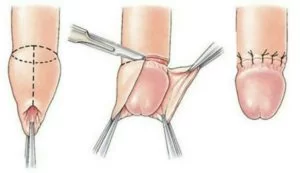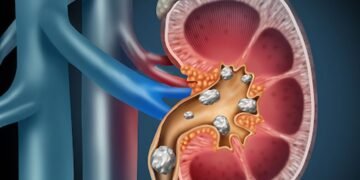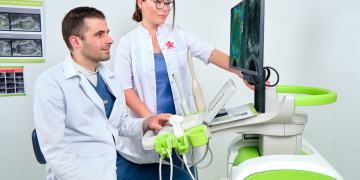Phimosis is a condition where the foreskin of the penis is too tight to be pulled back over the head of the penis. Phimosis can be congenital or acquired. In newborns, phimosis is considered a physiological condition; it is possible to completely move the foreskin from the head of the child’s penis in only 4% of newborn boys, and in 90% by the age of 3 years.
This pathological condition prevents the normal cleaning of the glans penis and contributes to the accumulation of a special substance called smegma between the glans and the foreskin. Smegma is the secretion of the glands of the inner fold of the foreskin. When it accumulates more than normal, pathogenic microbes have favorable conditions for reproduction. That’s why it’s necessary to observe personal hygiene by regularly washing the penis with warm water and soap. Otherwise, balanoposthitis may develop, which is inflammation of the glans penis and the inner layer of the foreskin, often followed by the spread of infection in an upward direction, involving the urethra and sometimes the bladder in the inflammatory process.
Acquired phimosis develops as a result of injury or a specific disease.
Adult males may have phimosis since childhood or acquire it during puberty. During this period, a discrepancy sometimes appears between the development of the penis and the foreskin – the foreskin arch lags behind in size from the enlarged glans penis, and it is so narrow that it is impossible to fully open the head of the penis. Unfortunately, the disease progresses due to erection, masturbation, and sexual activity. During an erection, the glans penis enlarges, and the penis is pulled out with difficulty, and microcracks appear along the edges.
As a rule, the microcuts caused by phimosis are very small, do not bleed, and do not cause much trouble at first. During the healing of the microcuts, micro-scars are formed on the damaged areas. Scar (connective) tissue is less elastic, so each new scar deepens the pathological process, narrowing the lumen more and more.
As the disease progresses, more severe and bleeding injuries to the tip of the penis may occur during intercourse. With severe phimosis, emptying the bladder is difficult, causing overstretching and stretching of the bladder wall, contributing to the development of the inflammatory process and the formation of stones. Among the complications of phimosis, it’s worth mentioning paraphimosis, where the glans penis gets stuck in the foreskin, causing the glans and foreskin to swell. In such cases, immediate surgical intervention is necessary.
Another serious complication of phimosis is balanoposthitis, which is inflammation of the glans penis and the inner fold of the penis.
Treatment of phimosis
 The cure for phimosis is not amputation but circumcision. Currently, there are several types of circumcision developed by different surgeons. In general, a distinction is made between complete and incomplete circumcision, in which complete or partial circumcision of the foreskin occurs.
The cure for phimosis is not amputation but circumcision. Currently, there are several types of circumcision developed by different surgeons. In general, a distinction is made between complete and incomplete circumcision, in which complete or partial circumcision of the foreskin occurs.
Experts believe that circumcision also reduces the likelihood of sexually transmitted diseases such as syphilis, genital herpes, and others. Circumcision facilitates the hygiene of the genital organs as sperm is released in a much smaller amount. Regarding the negative effects of circumcision, with poor-quality performance of the procedure and non-sterile instruments, as well as during other surgical procedures, it is quite possible that the wound will be complicated by the inflammatory process. Suppuration of the wound contributes to the proximity of the anus and poor hygiene in the postoperative period. Circumcision is sometimes accompanied by deformation of the genital organs. Incorrect execution of the procedure, such as cutting off more than necessary area of the skin fold, can cause stretching of the skin covering the penis and deformity of the penis.
The risk of these complications is minimized in the hands of experienced surgeons. Therefore, one should not be afraid of the possibility of complications of surgical procedures. It is recommended to realize the need for surgery and consult a specialist doctor to solve the problem.
MMT Hospital offers treatment for phimosis using methods in accordance with the standards of world medicine.











